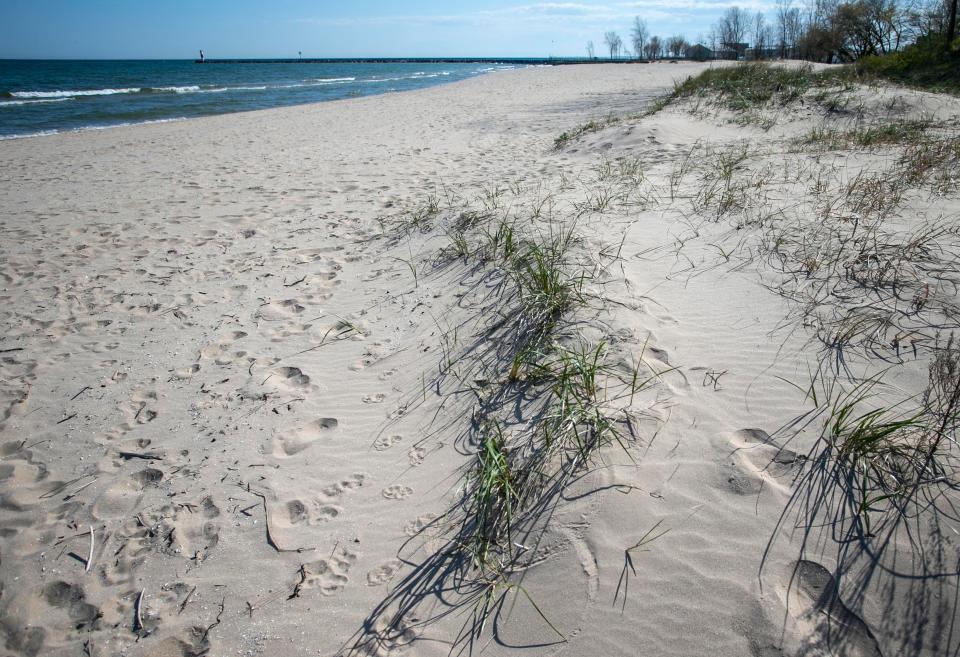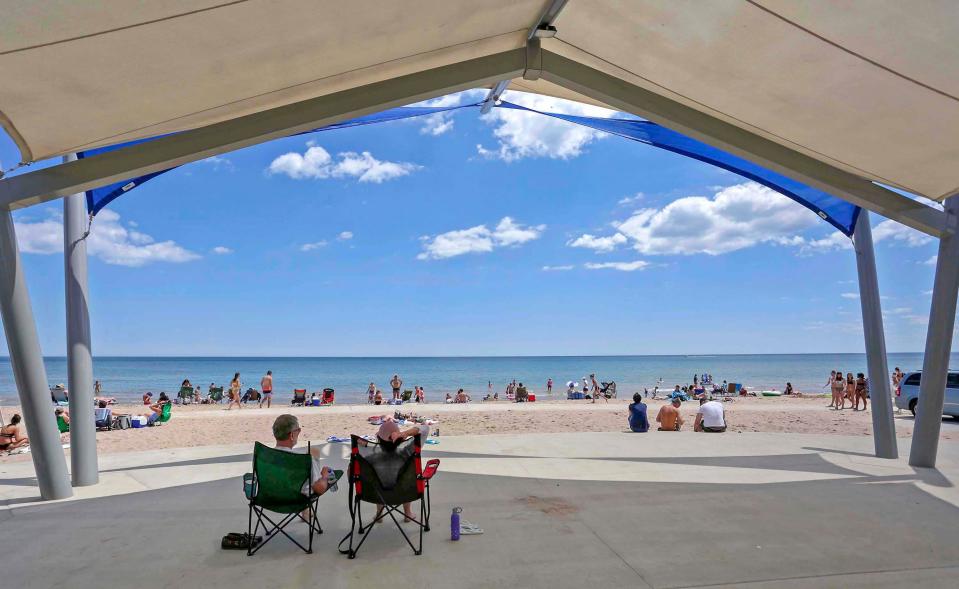'The beach is back' in Two Rivers. What lower Lake Michigan water levels mean for beachgoers and the kite festival.
TWO RIVERS - Boaters looking to use their docks, hikers eager to hit Mariners Trail and families hoping to catch some sun at Neshotah Beach this summer are in luck — they can expect Lake Michigan water levels to be calm after a few years of extreme highs and lows.
That’s great, experts say, but they don’t expect water levels to stay put. They say lakeside residents and communities should expect increasingly rapid swings up and down as climate change impacts the Great Lakes, making shorelines more volatile as trillions of gallons of water come and go.
Record rainfall and precipitation in 2019 helped cause water levels in lakes Michigan and Huron, which are considered one body of water, to rise 3 feet above average. Water levels fell in 2021, and in April of this year, levels are about 9 inches above the long-term average.
Overall, levels rose about 6 feet from record lows in 2013 to the highs of 2019-20. Water levels now have fallen about 28 inches in the past two years.
“We have some environmental theories about the climate warming and the radical ups and downs and changing cycles every six or seven years,” Two Rivers City Manager Greg Buckley told the Herald Times Reporter. “Is this the new normal to get used to?”
Kites Over Lake Michigan hopes to return to Neshota Beach
When water levels rose in 2019, the city of Two Rivers placed large stone around its Public Works Plant on Lake Street to prevent flooding.
Heavy rains and storms pounded the shoreline that year near the Two Rivers breakwater, and City Engineer and Public Works Director Jim McDonald said at the time the city lost ground to Lake Michigan after every storm.
The city used rip-rap to preserve sidewalks and trails they had just poured and placed boulders along the shore to protect trails and bridges.
Bottom steps along stairways leading to the lake had to be repaired.
The city spent about $200,000 in repairs and damage control as a result of high waters, Buckley said.
More than half the beach at the Neshotah Beach Park in Two Rivers was underwater in 2020, forcing Kites Over Lake Michigan to move to Two Rivers High School. The popular event was held at the high school again in fall 2021. Buckley is hopeful it will return to Neshotah this year.
The city plans to groom the beach farther north this year and has permission from the Wisconsin Department of Natural Resources to groom the new “North Pier Beach” tucked near the U.S. Coast Guard building off Harbor Road and 16th Street near the Northern Pierhead Light Tower south of Neshotah Park.
That beach was formed after the U.S. Army Corps of Engineers pumped 67,000 cubic yards of sand from Lake Michigan to the shore.
“It’s great news that the beach is back,” Buckley said. “We wouldn’t mind if levels would go down another foot or so, but it’s great they are going down and people will have more beach to enjoy.”
City leaders keep a close eye on water levels and ways to prepare for the swinging changes from year to year, Buckley said.
Coastal erosion and flooding won't 'be an issue this year'

Results from a survey of 241 municipalities in the Great Lakes region show coastal damage from climate change could cost nearly $2 billion over the next five years.
These communities have already spent $878 million for repairs in the past two years.
Rain and snowfall have the biggest impacts on the Midwest, according to Great Lakes Integrated Sciences and Assessments. Over the past 70 years, the region has seen a 14% increase in precipitation, according to a report from the organization.
Rainfall led many of the record-breaking water-level reports from the U.S. Army Corps of Engineers. In 2021, rainfall was more variable, and by fall, rainfall in lakes Michigan and Huron fell below the average.
Winter evaporation plays another role.
Keith Kompoltowicz, chief of watershed hydrology for the Army Corps of Engineers, noted the Great Lakes have seen warmer water temperatures going into the winter and ice cover of the lakes occurring later into the season. Diminished ice coverage in the winter paired with high surface temperatures contribute to additional water loss through evaporation.

The lakes had very light ice cover this year, but then a cold snap occurred in January and February, leading to 56% ice cover, kicking up the evaporation rate.
More evaporation takes place in fall and early winter when surface water temps are still relatively high and the surrounding air cools.
When air temperatures in winter don’t dip, less evaporation takes place.
Models from the Army Corps of Engineers showed lakes Superior, Michigan-Huron and Ontario experienced below-average evaporation in winter 2020. Kompoltowicz expects it to be closer to average this winter.
MORE: Lake Michigan Triangle: The source for unexplained Great Lakes shipwrecks and disappearances
A 2019 report from the Environmental Law and Policy Center said the Great Lakes region is warming faster than other areas of the United States over the past 100 years. The changes could mean more extreme highs and lows.
“We really don’t know what’s going to happen,” Buckley said. “It’s a delicate balance of needs. The perfect lake level is different for everyone. The coastal erosion and flooding in the past few years really hurt infrastructure. The good news for people living near the coast is it’s not going to be an issue this year."

CONTINUE YOUR SUPPORT: Thanks to our subscribers for making this coverage possible. Be sure to download our app on the App Store or Google Play. Follow us on social media: Facebook | Twitter | Instagram | Newsletters
Contact reporter Patti Zarling at 920-606-2586 or send an email to pzarling@gannett.com. Follow her on Twitter @PGPattiZarling.
This article originally appeared on Manitowoc Herald Times Reporter: Lower Lake Michigan water levels create more beach space in Two Rivers

